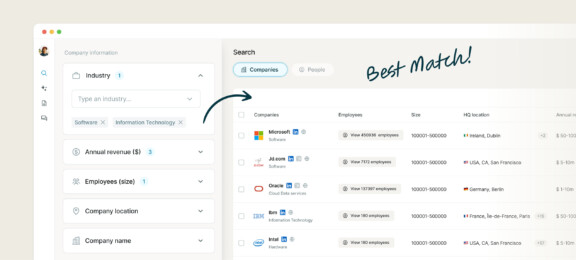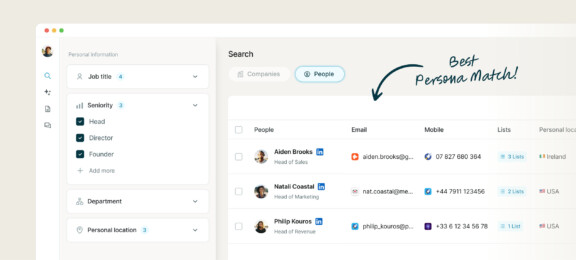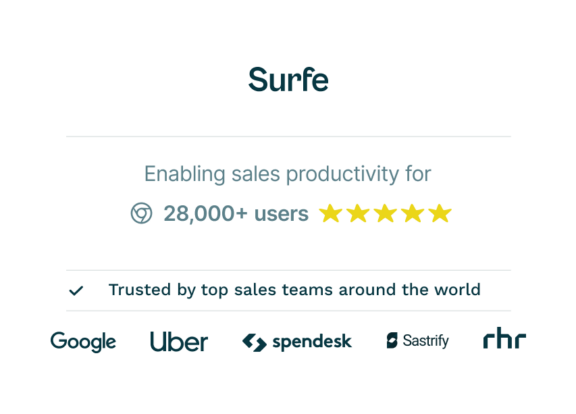How to Prospect in a Saturated Market

Things that are daunting:
Speaking up in a meeting full of senior colleagues. Your target for next quarter. Cold calling (duh).
You know what else is daunting?
Stopping and thinking about just how many other businesses are out there, doing exactly the same thing as yours. In the US alone, there are over 3 million B2B businesses – and you’re supposed to make your pitches stand out?! Cool, no big deal – excuse us while we go and cry in the corner.
Here’s the thing: unless you’re selling a product that’s literally the very first ever in the market, you’re going to have to stand out against competitors – and every other business pitching your prospects, even if they sell something different.
It can be tempting to go a bit left-field with your prospecting in an effort to stand out – but actually, you want to do the opposite. Success in markets like this hinges on a strategic, data-driven approach. The more precisely and quickly you can target, personalize, and engage each prospect, the more successful you’ll be. And that’s exactly what we’re going to talk about today:
- Identifying the Right Prospects with Precision
- Mapping Decision Makers in Target Organizations
- Reaching Prospects Before Competitors
- How Surfe Solves These Challenges
By the time you’ve finished reading, you’ll be acting with more precision than your competitors – and standing out as a result. Let’s get going.
Identifying the Right Prospects with Precision
The first step of prospecting is understanding who you’re actually going after. In other words, who matches your Ideal Customer Customer Profile (ICP)?
If you’re not entirely sure who’s most likely to buy from you, you’re inevitably going to spend time on leads who are a total dead end. This is 1) a waste of your time and 2) takes valuable effort away from leads who you might be in for a chance with.
If we had to sum up what your ICP should look like, we’d say it’s a company that you can genuinely solve a critical problem for. If your solution is a must-have for them, then you’re on the money.
Figure this out, and your outreach will become way, way easier – and you’ll stand out against other sales reps who don’t put in the same groundwork (for example, 42% of sales reps make a call without feeling like they have sufficient information for it).
So, How Can I Identify Potential Leads?
We’d recommend using advanced search and lookalike tools to find companies that precisely match your ICP. Weirdly enough, we have happen to have just the recommendation for you – Surfe!
Surfe has powerful filters that let you narrow down a huge database of over 4.5 million contacts. You can build a list based on revenue, headcount, location, technographics, and more – and never reach out to a dud lead ever again.
It also has a cool feature called ‘Company Lookalikes’. If you have an ideal customer or dream client, pop them into the tool and it will pull up loads just like it. Magic.
Surfe aside, we’d also recommend using third-party data tools like G2 to gain a more granular understanding of prospect needs and behaviors. The more you know, the better your prospecting will be. Trust us on this one.

Mapping Decision Makers in Target Organizations
On average, 6-10 decision-makers are involved in the B2B buying cycle. And 90% of the buying journey is complete before sales pros like us even get a look-in.
That means you’ve got to map out decision-makers fast. Like, really fast – otherwise you risk undertaking the sales process without the full picture.
If you don’t know exactly who’s on the buying committee, you risk getting the dreaded surprise stakeholder at decision time – who, having not experienced your charisma and charm, may be more inclined to take an ax to the entire deal.
How Can I Identify Decision-Makers?
To make sure you understand exactly who’s involved in the decision from the get-go, we’d recommend using a platform that can help you find key stakeholders and decision-makers.
If you’re after a specific recommendation, we’ve got just the ticket…oh look, it’s Surfe again!
Surfe helps you quickly map decision-makers and discover key roles within a company to cover all bases. Once you’ve got a company you like the look of, you can jump into the ‘People’ section to find out everything you need to know about the people that work there – job title, seniority, department, personal location…perfect.
You can also use Surfe to enrich these profiles with accurate email addresses and phone numbers, and then sync all this new information to your CRM. In other words, spend five minutes on the tool and you’ll have everything you need to start working the entire buying committee – no surprises.
You’ll be covering all internal concerns from the get-go, and speeding up the deal cycle in the meantime. Love it.

Mastering Personalization in Outreach
Personalization matters. Give your emails the personal touch, and you’ll enjoy a 29% open rate and a 41% click-through rate.
Personalization doesn’t mean writing ‘Hi [NAME]’ – that’s a given – instead, we’re talking about segmenting your email lists and focussing on intent-driven messaging to really boost engagement. If your prospect really feels your email speaks to them and your problems, they’ll be far more likely to believe that your product can solve your problems. Simple.
Strategies for Effective Personalization
So, how can you personalize your messaging – without spending hours writing each prospect a totally unique message?
Enriched data such as company size, industry trends, and recent activity can help here. For example:
- You might reach out to prospects in a certain industry that’s just had a new law pass or undergone a big change.
- Perhaps you know that companies over a certain number of people tend to struggle with growing pains – and low and behold, your product helps with exactly that.
- Maybe you know (thanks to Surfe’s technologies filter 😉) that certain companies are using a piece of tech that’s super outdated, and you know your product could replace it.
Both of these examples would result in a hyper-relevant message that speaks directly to prospect problems – see what we mean?
Here you want to use a balance of automation and personalization. Use an automation tool to handle the time-consuming parts of prospecting – follow-up messages, for example – while undertaking careful research to make sure each message you send is insight-driven.
Reaching Prospects Before Competitors
Obviously, you want to get to your prospects before your competitors do. 50% of sales go to the vendor who responds first – that’s a pretty simple way to dramatically increase your win rates.
Speeding up Contact Strategies
You need to make finding contact details as easy as is humanely possible. The faster you get the information you need, the faster you’ll be able to send over your winning (personalized) pitch. Surfe – spoiler alert – can help with that. It takes just one click from you to find accurate, verified email addresses and phone numbers, and deliver them into your CRM. Prospecting in one click – pretty cool, right?
You also need to respond promptly to anyone who comes your way. Replying to an inbound inquiry (ideally within the first hour) can make you 7 times more likely to have a meaningful conversation with a decision-maker.
Think multi-channel, too; pop up in your prospect’s inbox, LinkedIn feed, and voicemail, and you’ll be far more likely to actually get hold of them – fast.
Let’s Wrap It Up!
What exactly did you think was scary again?
Prospecting in a crowded market might seem intimidating, but really it just comes down to being as precise as possible in your approach. Send your prospects timely messages that feel perfectly tailored to them and their needs, and they’ll be falling at your feet before you know it.
Suddenly that quarterly target doesn’t seem too intimidating either – nice!

When it comes to prospecting, there’s one tool to rule them all.
Meet Surfe – you won’t be able to prospect without it. Give it a go, and see what we mean.
FAQs About Prospecting in a Saturated Market
What’s the First Step to Prospecting in a Saturated Market?
Start by identifying your Ideal Customer Profile (ICP). This makes sure you focus on prospects who genuinely need your solution – and are therefore more likely to buy from you. Once you’ve got your ICP down pat, start to find companies that fit the bill. A tool like Surfe can help with this – its powerful filters allow you to search a huge database by criteria like revenue, headcount, and industry. By zeroing in on the right prospects, you’ll save time and stand out from competitors who don’t do the groundwork.
How Can You Map Decision-Makers in Target Companies?
Map decision-makers early to avoid the dreaded surprise stakeholder derailing your deal. Platforms like Surfe make this simple by providing access to job titles, seniority, and contact details too. With these insights, you can address concerns across the buying committee and build a more compelling case for your solution. Mapping decision-makers shortens the deal cycle and makes sure no key stakeholder is overlooked.
How Do You Personalize Outreach Effectively Without Spending Hours?
Personalization goes beyond just addressing your prospect by their name. Segment your audience and tailor your messaging based on company size, industry trends, or recent activity. For example, highlight how your solution addresses challenges specific to their sector or solves problems caused by outdated tools. Tools like Surfe help you enrich data quickly, so your outreach resonates quickly.
What’s the Best Way to Reach Prospects Before Competitors?
Speed matters – 50% of sales go to the vendor who responds first. Use tools like Surfe to quickly find verified contact details and sync them with your CRM. Respond promptly to inbound inquiries and adopt a multi-channel strategy. Reach out via email, LinkedIn, and even voicemail to engage your prospect on their preferred platform. Acting quickly gives you a critical edge in crowded markets.
Why Is Precision Important When Prospecting in Crowded Markets?
Precision helps you focus your efforts where they’ll have the most impact. By targeting the right prospects with personalized, timely messages, you’ll stand out from competitors who take a scattergun approach. Surfe’s has a database of 4.5 million contacts, helping you to filter and find the best matches for your ICP. A data-driven approach makes sure you engage prospects who genuinely need your solution, making your outreach more effective.
How Can You Use Automation Without Losing the Personal Touch?
Automation is a time-saver, but it needs a personal touch to succeed. Use tools to handle repetitive tasks like follow-ups while dedicating time to crafting personalized messages based on enriched data. For instance, reference specific industry challenges or company milestones in your emails. This combination of automation and insight-driven messaging keeps your outreach efficient without sacrificing relevance or authenticity.


